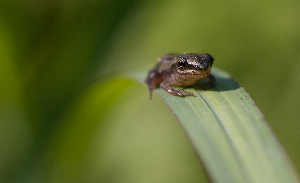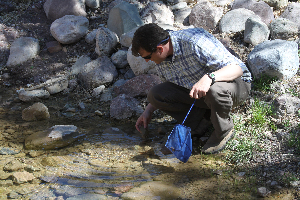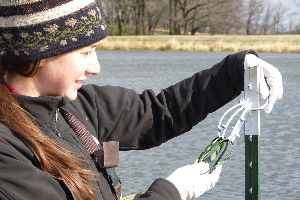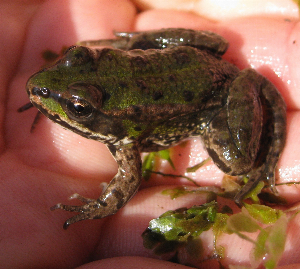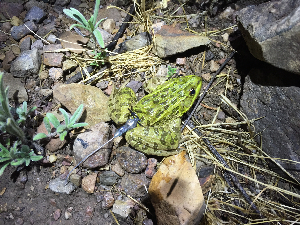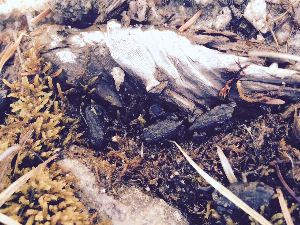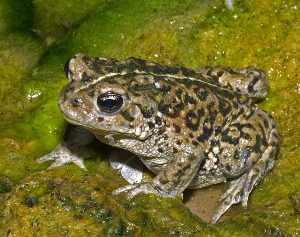Search ARMI Database
Search term(s)
Contribution Number
Search Results
180 record(s) found.
Papers & Reports Twenty-nine years of population dynamics in a small-bodied montane amphibian
Papers & Reports Quantifying climate sensitivity and climate driven change in North American amphibian communities
Papers & Reports Exploring the amphibian exposome in an agricultural landscape using telemetry and passive sampling
Papers & Reports Heterogeneous responses of temperate-zone amphibian populations to climate change complicates conservation planning
News & Stories ARMI scientist involved in workshop in Hyderabad, India: Long term Wildlife Monitoring, Ecological and Statistical Considerations.
The Amphibian Research and Monitoring Program has a reputation for taking wildlife monitoring to new levels using robust methods that allow synthetic data analyses across landscape scales. Because of this reputation, ARMI scientist Dr. Erin Muths was invited to lecture and mentor at a workshop in Hyderabad, India in November 2018. The workshop was titled Long term Wildlife Monitoring: Ecological and Statistical Considerations. The workshop was one component of an Indo-U.S. 21st Century Knowledge Initiative grant to Dr. Barry Noon at Colorado State University. The workshop was hosted by Dr. Karthikeyan Vasudevan at the Laboratory for the Conservation of Endangered Species (LaCONES), Centre for Cellular and Molecular Biology (CCMB). Attendees included early graduate students, post-doctoral researchers, and early career professionals. Interactions within and outside the classroom were completely positive.
The workshop focused on analytical methods, applications to particular datasets, field techniques, and examples of long-term monitoring programs (from organizational structure and methodology to data and products). The workshop material was rounded out with a variety of speakers including Dr. Arjun Gopalaswamy, Wildlife Conservation Research Unit, Oxford University, Dr. Kim McConkey, University of Nottingham-Malaysia, and Dr. Jagdish Krishnaswamy, Ashoka Trust for Research in Ecology and the Environment.
In addition to lecturing, Erin also spent time mentoring new graduate students and is, (along with Dr. David Miller, former ARMI post-doc, now at The Pennsylvania State University), a member of Gayathri Sreedharan's PhD committee (Jawaharlal Nehru Univesity, New Delhi / CCMB-LaCones). Ms Sreedharan's dissertation title is: Dynamics of enzootic/epizootic Batrachochytrium dendrobatidis infection in a community of stream amphibians from the Western Ghats.
This was a fantastic opportunity to help to build capacity in a country with stunning wildlife, but few resources for conservation. This effort illustrates ARMI's ability to address amphibian conservation needs, but also showcases the impact of USGS programs and leadership in the global community. Building partnerships and sharing information abroad deepens our understanding of the issues and increases our ability to effectively address partner science needs at home.
Papers & Reports Increasing connectivity between metapopulation ecology and landscape ecology
influences ecological processes, yet these disciplines address the problem using fundamentally different modeling approaches. Metapopulation models describe how the spatial distribution of patches affects colonization and extinction, but often do not account for the heterogeneity in the landscape between patches. Models in landscape ecology use detailed descriptions of landscape structure, but often without considering colonization and extinction dynamics. We present a novel spatially explicit modeling framework for narrowing the divide between these disciplines to advance understanding of the effects of landscape structure on metapopulation dynamics. Unlike previous efforts, this framework allows for statistical inference on landscape resistance to colonization using empirical data. We demonstrate the approach using 11 yr of data on a threatened amphibian in a desert ecosystem. Occupancy data for Lithobates chiricahuensis (Chiricahua leopard frog) were collected on the Buenos Aires National Wildlife Refuge (BANWR), Arizona, USA from 2007 to 2017 following a reintroduction in 2003. Results indicated that colonization dynamics were influenced by both patch characteristics and landscape structure. Landscape resistance increased with increasing elevation and distance to the nearest streambed. Colonization rate was also influenced by patch quality, with semi-permanent and permanent ponds contributing substantially more to the colonization of neighboring ponds relative to intermittent ponds. Ponds that only hold water intermittently also had the highest extinction rate. Our modeling framework can be widely applied to understand metapopulation dynamics in complex landscapes, particularly in systems in which the environment between habitat patches influences the colonization process.
Papers & Reports Host pathogen metapopulation dynamics suggest high elevation refugia for boreal toads
Papers & Reports Status of the Threatened Chiricahua Leopard Frog and Conservation Challenges in Sonora, Mexico, with Notes on Other Ranid Frogs and Non-native Predators
News & Stories Interpretive sign highlighting the federally threatened Chiricahua Leopard Frog debuts at Buenos Aires National Wildlife Refuge
An interpretive sign was installed on August 1st, 2017 near the headquarters and visitor information office at Buenos Aires National Wildlife Refuge (BANWR, Sasabe, Arizona). The sign provides information on the federally-threatened Chiricahua Leopard Frog (Lithobates chiricahuensis) and is located next to an example of typical habitat (a cienaga). In addition to the biology and behavior of this desert frog, the sign gives a friendly reminder to brake for amphibians on Refuge roads, especially during the summer monsoon season when amphibians are more likely to be moving between habitats; in the desert, as for many animals, the cienagas and cattle tanks retain water and are key refuges during drought.
This interpretive sign, the first highlighting an amphibian on BANWR, was originally designed to educate visitors about the Chiricahua Leopard Frog, but the sign has become a template and an inspiration for further educational efforts. Additional signs are in the works at BANWR to provide interpretive information along a planned nature walk near Refuge headquarters and at the flight pen for the federally endangered Masked Bobwhite Quail. Based on the design of the Chiricahua Leopard Frog sign, interpretive information is being created to highlight all of the diverse flora and fauna at BANWR and give the visitor a better idea of the complex and interconnected lives of the organisms they might encounter as they enjoy the scenery and arid landscape of the Refuge.
The Chiricahua Leopard Frog interpretive sign was a concept initiated during a stakeholder meeting in February 2017, at BANWR, where decision science methods were applied to discuss refuge priorities (e.g., Chiricahua Leopard Frog conservation, general refuge management). Stakeholders included personnel from U.S. Fish and Wildlife Service, Arizona Game and Fish Department, U.S. Geological Survey, and the University of Georgia. The sign was designed through collaborative effort among those entities and funded via Jones-Lovich grant in Southwestern Herpetology from the Herpetologists' League. Work on declining amphibians at BANWR and the Borderlands was initiated by Cecil Schwalbe (USGS, ARMI-retired) and has been continued by Brent Sigafus, Blake Hossack and Erin Muths (Rocky Mountain and Southwest ARMI).
Papers & Reports Factors Influencing Anuran Wetland Occupancy in an Agricultural Landscape
Papers & Reports Identifying Species Conservation Strategies to Reduce Disease-Associated Declines
Papers & Reports Evaluation of wetland mitigation in the Geater Yellowstone Ecosystem: Wildlife population and community responses
News & Stories New graduate student starts at Colorado State University, funded jointly by ARMI, Colorado State University, and Rocky Mountain National Park.
A new graduate student has started work on boreal toads this summer in Rocky Mountain National Park (RMNP). John Crockett completed his undergraduate degree at Colby College and successfully garnered a funded graduate position in Larissa Bailey's lab at Colorado State University (CSU). He will be working with ARMI scientist Erin Muths and Larissa Bailey to examine factors that influence boreal toad survival from egg to one year old toads. During the past 15 years, breeding by boreal toads has been documented at only six sites within RMNP and in 2016 breeding occurred in only four of these remaining sites. Batrachochytrium dendrobatidis, a fungal pathogen which causes a fatal skin disease in amphibians, has been credited as the cause of the recent and rapid declines of boreal toads in RMNP and has been identified at three of these sites. Quantifying breeding success and understanding factors that impact survival in early life stages of toads are poorly known aspects of their ecology. One of these factors is the potential negative interaction between trout and aquatic stages of toads (egg and tadpoles). Laboratory evidence suggests that trout will "taste" tadpoles, while not lethal, it does effect survival. A behavioral component to this project will examine interactions between trout and aquatic stages in the field. In addition to newly collected data on behavior, egg deposition, hatching success, and metamorph survival, this jointly-funded project will capitalize on long-term existing data from Muths' lab and RMNP. We anticipate that this information will help us understand factors that impact early life stages of toads and identify situations where we may be able to intervene and improve survival rates, thus informing management strategies and contributing to conservation of the toad.
ARMI in Action Boreal toad considered for listing by FWS
ARMI in Action Boreal toad conservation plan for Colorado updated
Papers & Reports Amphibians, pesticides, and the amphibian chytrid fungus in resetored weltands in agricultural landscapes
Papers & Reports Informing recovery in a human-transformed landscape: drought-mediated coexistence alters population trends of an imperiled salamander and invasive predators
News & Stories The 2016 ARMI meeting was held at the National Wildlife Health Center (NWHC) in Madison, Wisconsin
The 2016 ARMI meeting was held at the National Wildlife Health Center (NWHC) in Madison, Wisconsin. ARMI scientists met with disease researchers from NWHC to develop a new disease strategy designed to meet the need for increased information on how aspects of the environment can be managed to understand and reduce the effect of disease on amphibian populations. Disease has been an integral part of ARMI efforts since the inception of this program when the amphibian chytrid fungus and its devastating effects on amphibians was first identified. Now, the complex topic of disease has again come to the forefront of public and scientific consciousness with the recent emergence of a number of infectious diseases such as white-nosed syndrome in bats and the salamander chytrid fungus (Batrachochytrium salamandrivorans) in amphibians. Additional topics at the meeting focused on research results, including projects as diverse as decision science, amphibian presence relative to gas and oil development, demographic estimates for a number of focal populations, international collaborations, and modelling and methods development. Synergies resulting from this cross discipline (e.g., biology, contaminants, water, disease) effort are critical to develop the knowledge base, direction and tools to effectively combat the global issue of amphibian decline.

